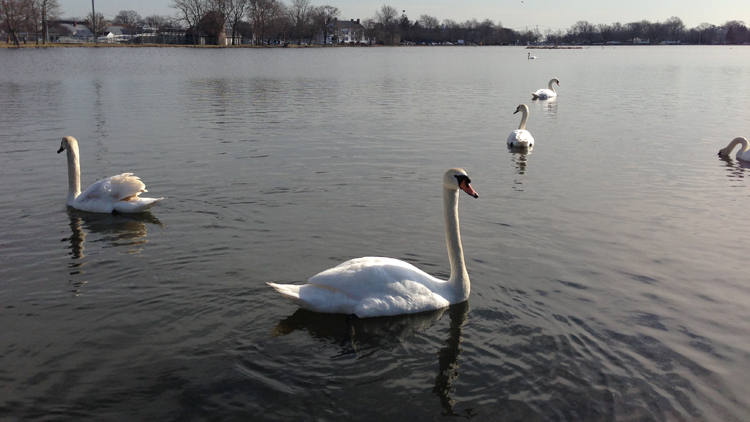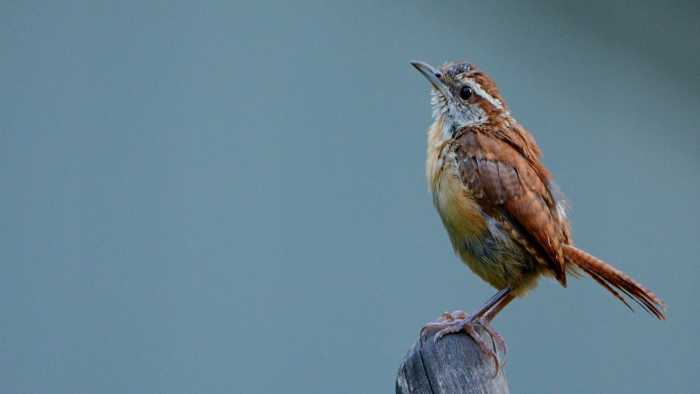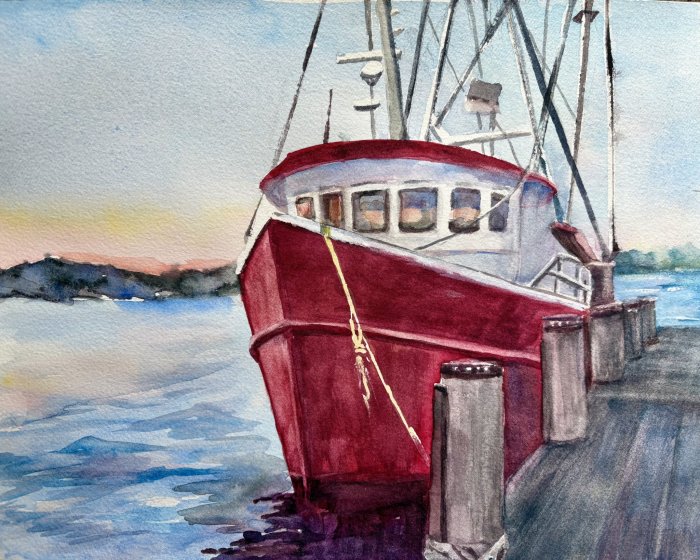By Sylvia Durres
The clock is ticking on Long Islanders’ chances to help decide the fate of those large, fluffy white swans gracefully drifting atop the water of countless ponds and lakes throughout Nassau and Suffolk.
Friday marks the final day for public comment on the latest New York State Department of Environmental Conservation (DEC) management strategy for these large, silent birds—known as mute swans, or their scientific name, Cyngus olor—a plan that has already been revised due to fierce outcry among residents and wildlife advocates for the beloved creatures. Those who wish to comment are advised to email the DEC at Wildlife@dec.ny.gov with “Swan Plan” as the subject line.
Recognized by their long, arched necks and orange-and-black-striped-and-knobbed bills and renowned for their beauty as they glide across the water bodies of Nassau and Suffolk and throughout the state, these gentle giants are not native to Long Island, the region, or the United States, and are classified as an “invasive species” by the agency.
The swans were brought to North America from Eurasia as ornamentals to beautify estates in the late 1800s, says the DEC, and those that were intentionally released or escaped established populations that flourished, becoming established in the early 1900s. There are presently approximately 2,200 of the feathery waterfowl statewide, it adds.
This, the agency deems a serious problem, and outlined its gripes with the snow-colored sailors in its 2013 draft “Management Plan for Mute Swans in New York State,” listing among those: “aggressive behavior towards people, destruction of submerged aquatic vegetation (SAV), displacement of native wildlife species, degradation of water quality, and potential hazards to aviation.”
“Mute swans are conspicuous birds that occur in some of the most densely populated areas of the State,” reads the analysis, noting some people’s affinity for the birds. “Mute swans have little or no fear of humans so they are easily observed and provide opportunities for people to come in close contact with them. Some people become protective of individual birds that they encounter regularly.
“However, mute swans can cause problems for people too,” it contends. “Some swans will directly attack humans, especially small children, who get too close to nests or young… The potential for injury is low, but the aggressive behavior of swans can be a serious nuisance and render some land or water areas inaccessible for outdoor recreation during the nesting season. Where large flocks occur on water bodies used for drinking water or swimming, the deposition of fecal matter may contribute to high fecal coliform counts which in turn may be a concern to local public health and municipal water supply officials. Mute swans have also been associated with high fecal coliform counts in coastal waters, which could affect some shellfishing areas on Long Island.”
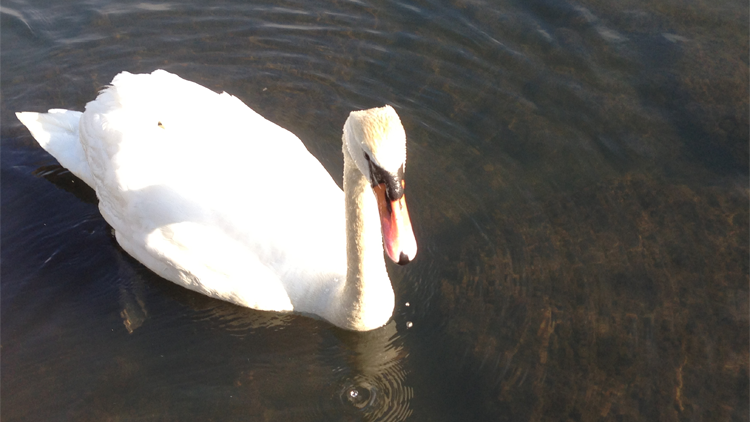
The DEC has been operating under a mute swan management policy adopted in 1993 by the Division of Fish and Wildlife and Marine Resources (now combined as the Division of Fish, Wildlife and Marine Resources, or DFWMR), according to the report, which states that policy “permits removal of mute swans from lands administered by DFWMR, prohibits release of captive mute swans into the wild and authorizes issuance of permits for swan control by others on a site-specific basis.”
“This new plan supports further action by DEC to eliminate free-ranging mute swans from New York by 2025, while allowing responsible ownership of these birds in captivity,” it continues.
In order to meet this elimination goal, the agency considered a series of methods to eliminate the “free-ranging” swans, including shooting, euthanizing, sterilizing and capturing them and destroying their nests and eggs.
“Lethal control methods will include shooting of free-ranging swans and live capture and euthanasia in accordance with established guidelines for wildlife,” states the DEC’s original report, no longer available on the DEC’s website. “Consideration will be given to donating the meat (or any other parts of birds killed) to charitable organizations (e.g., food pantries) or scientific, educational or zoological institutions. Non-lethal population control methods may include nest destruction, treating eggs with corn oil or puncturing to prevent hatching, and surgical or chemical sterilization.”
The December 2013 draft plan also considered authorizing “property owners and others to conduct mute swan control activities.”
“Various control methods may be authorized,” it states, “including but not limited to: oiling, puncturing, shaking, freezing, replacing or removing eggs; destruction of nests; sterilization of birds; shooting; and capture and removal of swans to be euthanized or turned over to persons licensed to keep the birds in captivity.”
Thousands weighed in with e-mails, letters, form letter e-mails and signatures on various petitions during a public comment period ending Feb. 21 on the agency’s draft management plan released in January 2014.
“They are beautiful birds that people enjoy seeing in their daily lives, especially in urban environments,” blasted one response from the public, with many comments, along with the DEC’s respective responses to them. [Available for viewing HERE]
“Canada geese are a much bigger problem than swans, do something about them instead,” demanded another.
“Oppose use of any taxpayer funds for control of mute swans by DEC or others,” blasted yet another.
These concerns and many more were taken into consideration in writing their current plan, a “Revised Draft” released last month and open to public comment until 11:59 p.m. Thursday, April 24. [Read Revised Draft Plan HERE] Those who wish to comment are advised to email the DEC at Wildlife@dec.ny.gov with “Swan Plan” as the subject line.
“Wildlife management can present challenges in trying to balance conflicting interests, such as when a beautiful bird has undesirable impacts,” DEC Commissioner Joe Martens said in a statement regarding the latest plan [Read HERE]. “This revised plan remains committed to minimizing the impacts of mute swans on wildlife dependent on wetlands for their habitats, while being sensitive to public concerns about how and where that is accomplished.”
Among those revisions: rather than eliminating all free-flying swans, the new goal focuses on minimizing the bird’s impacts; permitting municipalities to keep swans at local parks and other settings pursuant to local swan management plans, as long as certain conditions are met; commitment to the full consideration of non-lethal techniques, including egg-oiling and placement of swans in possession of persons licensed by DEC, except where immediate removal of swans is necessary to protect public safety and health; and, among others, a more concise summary of the impacts mute swans can have, citing additional scientific studies.
“Because many people object to the use of lethal control methods, especially killing adult birds, DEC will use ‘non-lethal’ methods (i.e., egg-addling and placement at licensed facilities), where practical and timely, to achieve the management objectives,” it reads. “However, this will require some commitment of funding and assistance from organizations and individuals who wish to see non-lethal options used to the extent possible. Placement and proper care of swans in public parks or other controlled settings can be costly to local governments or communities, but if people who enjoy seeing mute swans are willing to support such programs, DEC will cooperate with those efforts.
“Complete elimination of mute swans from New York is not a viable option given the expressed public opinions associated with these birds,” it continues. “However, the demand for viewing swans can be largely met through closely regulated possession of mute swans for enjoyment in urban parks and other public settings. Measures are needed to ensure that those swans do not reproduce or leave those areas, to prevent their entry into wild populations or impacts on natural resources. Prohibitions on importation and commercial trade or propagation of mute swans are also needed to help prevent escapes or intentional releases of additional mute swans to the wild in New York.”
Controversial lethal and non-lethal methods are not entirely off the table, however, according to the agency’s revised plan.
“DEC staff will continue to conduct, assist or support mute swan control activities on any accessible public or private lands (with landowner consent) or waters in New York State to accomplish the objectives of this plan,” it reads. “Control options will include nest destruction, egg-addling (coating with corn oil), capture and placement of swans at licensed sanctuaries or other captive settings, shooting of free-ranging swans (where it can be done safely), and live capture and euthanasia. Where immediate removal of birds is not necessary to alleviate a site-specific conflict, full consideration will be given to use of “non-lethal” methods (i.e., egg-addling and placement at licensed facilities) to achieve desired population reductions.”
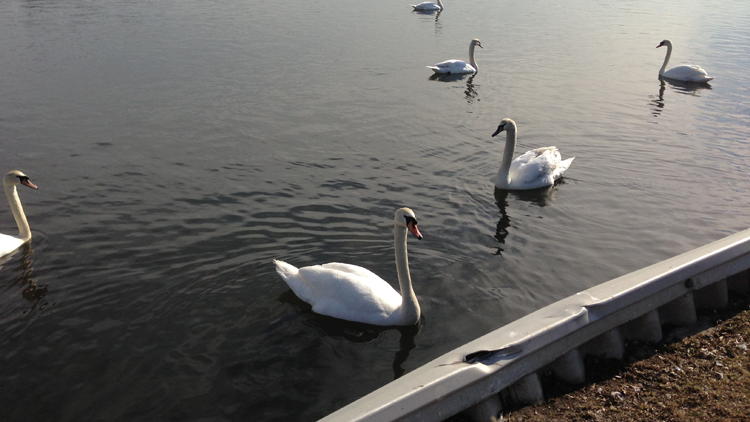
While the gorgeous closed-billed swans are deemed outlaws and enemies of the state here, the feathery mutes are exalted and even revered in other cultures and countries, glorified for their grace and beauty and actually protected by some world leaders.
The Danish, for example, honor the mute swan as their national bird.
The bird embodies the collective heart and imagination of all of Great Britain annually each third week in July, when the British Monarchy honors the centuries-old ceremony and celebration of “Swan Upping,” according to its official website.
The annual census of the swan’s population within several counties’ stretches of the Thames River, the Swan Upping ceremony entails several swan-specific officials—“The Queen’s Swan Marker, the Royal Swan Uppers and the Swan Uppers of the Vinters’ and Dyers’ livery companies,” it states—embarking on a celebrated five-day journey in rowing skiffs up-river, all wearing traditional scarlet uniforms and flying pennants and flags.
“When a brood of cygnets [young mute swans] is sighted, a cry of ‘All up!’ is given to signal that the boats should get into position,” explains the site. “On passing Windsor Castle, the rowers stand to attention in their boat with oars raised and salute ‘Her Majesty The Queen, Seigneur of the Swans.’”
Schoolchildren are invited to witness the grand event, and the birds are given a health check and tagged with rings by The Queen’s Swan Warden—a professor of ornithology at Cambridge University’s zoology department. The birds are also weighed and measured. The data gleaned from the Swan Upping is used to help guide conservation methods to protect the swans.
The celebration dates to the 12th Century, and today, the Royal Crown “retains the right to ownership of all unmarked mute swans in open water,” according to the website.
The renowned mute swans who reside within the moat at the more than 800-year-old medieval Bishop’s Palace in Wells, England, ring specialized bells when they are hungry and have become a popular tourist attraction. The Palace maintains an online diary of the swans’ activities, even referring to them by name.
As per the DEC:
Comments on the revised draft mute swan plan may be submitted in writing through April 24 to: NYSDEC Bureau of Wildlife, Swan Management Plan, 625 Broadway, Albany, NY 12233-4754 or by e-mail to Wildlife@dec.ny.gov (please type “Swan Plan” in the subject line).




